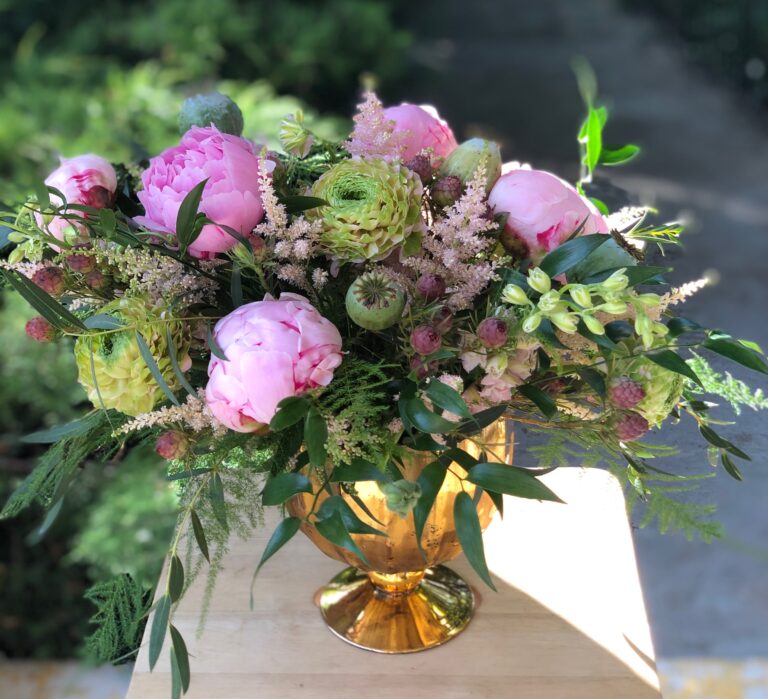
Home / The Flower Blog / How to Create Our Lush Peony Compote Arrangement

Ingredients:
Peony, Sarah Bernhardt (5)
Ranunculus, Pink Pon Pon (5)
Astilbe, Light Pink (7)
Poppy Pod (4)
Leucadendron, Jubilee Crown (6)
Larkspur, Pink (5)
Ruscus, Italian (3)
Parvifolia (2)
Plumosa (5)
Mallory Compote (1)
Flower Food (1)
Chicken Wire Pillow (1)
Directions:
Make the Chicken Wire Pillow:
Fold the chicken wire in half. Using needle-nose pliers, twist the ends together on both sides. Once completed, expand the chicken wire to form the shape of a pillow. Press the twisted ends in toward the center to create more of a ball shape. Insert the chicken wire into the Mallory Compote to create the grid
Starting the Arrangement:
Add a half packet of Flower Food to the compote, then fill the compote ¾ of the way with cold water and swish to dissolve the flower food.
The Italian Ruscus, Parvifolia, and Plumosa will be the first greens inserted into the vessel. As this is an Asymmetrical arrangement, one side should be longer and taller than the other. In the arrangement pictured above, I chose the left side to be longer and taller. Start with a stem of Ruscus and cut it in half. Remove the bottom leaves from the stem and insert the stem into the vessel and through the chicken wire grid. Continue with the other greens alternating between the three. The greens will provide the framework for the arrangement and will also help to cover the mechanic of the chicken wire
Now it is time to start working with flowers:
The first category of flowers to choose from is the line flower, which is the Pink Larkspur. There are not many of these, so they should be used very intentionally. The purpose is to exaggerate the asymmetrical lines of the arrangement – hence the term line flower. Gauge the length, but at an angle and insert the stems in the same varying lengths and heights of the greenery. Occasionally, there will be an exceptionally long Larkspur. In this case, you can cut this stem into multiple pieces, placing it all over the arrangement.
The next category of flower to choose is a face flower, which is the Peony. Hold the Peony up against the vase to gauge the length, and then cut the stem at an angle and insert it into the vase through the chicken wire grid at an angle that compliments to foliage. I started on the left side and followed the line of greenery that was most pronounced. Continue inserting all of the Peonies so that they are evenly distributed throughout the arrangement, but are at varying lengths and angles.
The Ranunculus is the next flower to add-in. This is another face flower and is used to fill negative space while complimenting the Peony. Similar to how the Peony was inserted, hold the Ranunculus up to gauge how long the stem should be and cut it at an angle. Place the Ranunculus in the larger spaces that are not taken up by the Peony. Again, insert at varying lengths and angles and make sure they are placed throughout the arrangement
The Leucadendron is the accent flower and is intended to complement the face flowers and add another texture. This flower should be measured, cut, and inserted very similarly to the Peony and Ranunculus. It should be evenly spread throughout the arrangement. A stem that has multiple offshoots can be taken apart so that more of the Leucadendron can be used throughout the arrangement
The Astilbe, which is a line flower, will add definition, layers, and additional texture. Although it appears delicate, the woody stem of the Astilbe can be handled the same way. Measure, cut, and insert. On occasion, some of the lower flowers can be removed from the stem so that the Astilbe can be more easily inserted. Evenly spread them throughout the arrangement making sure that one side of the arrangement is longer and taller than the other
Finally, measure and cut the Poppy Pod stems and place them into the arrangement in any space that needs additional coverage. They are used as a fun accent, but the strong line of the stem as helps to distinguish the arrangement
Once complete, place the arrangement in your favorite spot. I like this one best in my entryway. It makes me smile every time I come home. To get the most out of it, change the water every other day. I premix a little flower food in a bottle of water and have it nearby to add-in. As it is difficult to take the arrangement out of the vessel, just bring it to the sink, tip the old water out and add new water. Not all flowers are alike, so some will go before others (ie: the Astilbe). Just remove the spent stems as they go and enjoy the others as they hang around
Bedford Village Flower Shoppe
634 Old Post Road
Bedford, NY 10506
info@bedfordvillageflowershoppe.com
Mon – Fri: 10am – 5pm
Sat: 10am – 3pm
Sun: Closed
Same Day Delivery:
Orders must be placed before 3pm M – F, and 12pm Sat
Floral Arrangement Delivery Areas
©2023 Bedford Village Flower Shoppe. All rights reserved. Website by Action & Co.